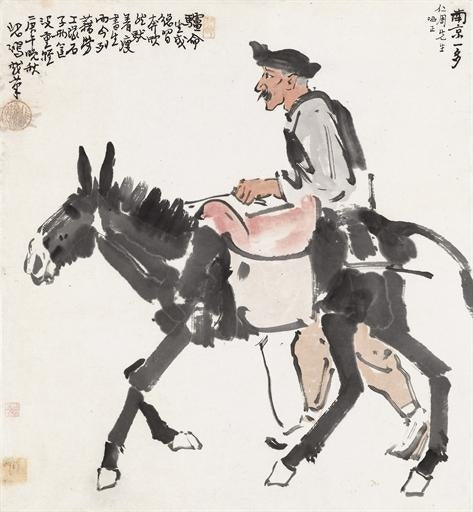Description
In the vastness of modern Chinese art, Xu Beihong stands out as a fundamental figure for its ability to merge Chinese traditional techniques with western influences, thus creating a unique and penetrating style. His work "Mounting in donkey" (1930) is an eloquent testimony of this synergy, revealing not only Beihong's technical mastery but also its deep cultural and artistic sensitivity.
The "riding" paint shows a man dressed in traditional clothes peacefully riding a donkey. The simplicity of the scene is misleading, because it contains a compositional complexity and a symbolism that emerge when they carefully contemplate each stroke of the Beihong brush. The figure of man is presented in a relaxed, almost contemplative posture, with one hand holding the reins and the other resting on the loin of the donkey. His serene expression contrasts with the inclined head of the donkey, which suggests a harmonious connection between man and the animal.
The Chinese ink technique that Xu Beihong uses is impeccable, with a masterful control of the intensity and fluidity of the ink on paper. The rapid and loose strokes that delineate the donkey transmit an innate vivacity, while the most controlled and detailed traces of the rider highlight their importance and centrality in the composition. This management of the technique reveals Beihong's ability to make the most of the expressive abilities of the environment, a legacy of his formations both in China and Europe.
The use of negative space is fundamental in this work. The fund is left essentially empty, allowing the figures to stand out without distractions, a prominent characteristic in many paintings Traditional Chinese. This approach creates an atmosphere of serenity and amplitude, as if the rider and its donkey were immersed in a vast landscape, lost in time. The absence of a detailed spatial context invites the viewer to project their own sense of place and history, generating a more intimate and personal connection with the work.
At the color level, the painting is restricted to a monochrome that is the essence of the tradition of Sumi-E, the Chinese ink paint style that prioritizes expression and simplicity over photographic realism. This chromatic minimalism not only underlines the purity and elegance of the strokes but rather focuses attention on the composition and internal dynamics of the scene.
Xu Beihong was not simply a painter; He was a fervent defender of Chinese art and an innovative who sought to revitalize and modernize past traditions. "Mounting in donkey" reflects this vision, while maintaining a deep respect for traditional art forms. This work can also be considered as a reflection of Beihong's own trip: a path of adaptation and reconciliation of influences from the East and West, always looking for a balance that now defines its legacy.
In conclusion, "Mounting in donkey" by Xu Beihong is a work that encloses a wealth of meanings and a great technical that transcends its apparent simplicity. It is a window open to the vast horizon of modern Chinese art, where traditions dialogue with foreign influences, and where the human spirit finds its most authentic and lasting expression.
KUADROS ©, a famous paint on your wall.
Hand-made oil painting reproductions, with the quality of professional artists and the distinctive seal of KUADROS ©.
Art reproduction service with satisfaction guarantee. If you are not completely satisfied with the replica of your painting, we refund your money 100%.

